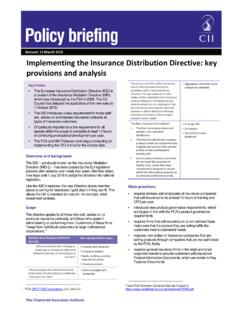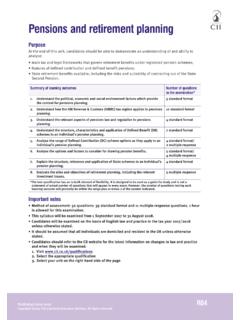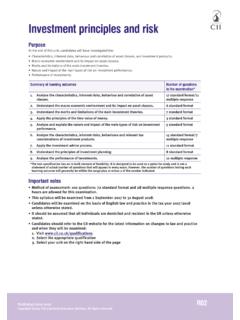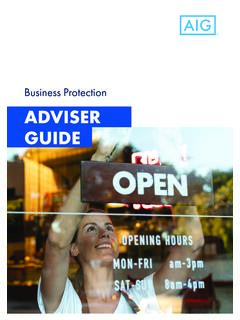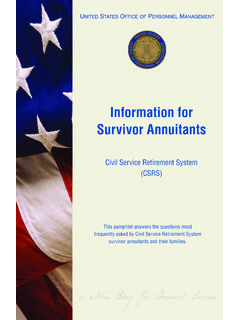Transcription of The Insurance Competency Framework
1 The Insurance Competency Framework A CENTURY OF. PROFESSIONALISM. The Insurance Competency Framework Contents User Specialist underwriting Risk perception and Technical Pricing the Insurance principles and Underwriting Insurance products and Underwriting Legal Compliance and operational risk Specialist intermediary Assessing and transferring The role and responsibilities of intermediaries ..31. Claims Negotiation and placement of risks ..32. Underwriting and pricing the Intermediary Claims Business Company and market Specialist claims competencies ..35. Understanding the Claims notification and Communication Claims Management of Claims Planning and People Negotiation and persuasion The Chartered Insurance Institute 2.
2 The Insurance Competency Framework User guide 3. The Insurance Competency Framework User guide What is a Competency Framework ? The CII Insurance Competency Framework Competency may be defined as the knowledge and skills that individuals must The CII's Insurance Competency Framework has been developed to provide have to perform effectively at work. A Competency Framework , therefore, is a an effective and externally benchmarked tool, which can be used to define structure that sets out and defines each individual Competency (such as product the minimum levels of competence required across a wide variety of roles and knowledge or communication skills) required by individuals, across the job roles job descriptions.
3 This is particularly important in the context of a regulatory within an organisation. In this sense a Competency Framework is about trying to set environment, where employees are required to demonstrate that they are an objective minimum acceptable benchmark of performance. Once established competent for the work they do and maintain and develop this competence. the Competency Framework can be used to identify knowledge and skills gaps for The CII's Insurance Competency Framework is a generic Framework which can both the individual and the employer. support a wide range of business operations providing Insurance services, both in However, Competency can also embrace those knowledge and skills that the UK and globally.
4 It provides a comprehensive guide to the knowledge and skills individuals must acquire to perform effectively. A Competency Framework can, which may be needed for different job roles. The Framework is designed to be used therefore, also support professional development pathways. By defining different as a guide for organisations wishing to develop their own bespoke Competency levels of Competency linked to job roles, individuals and their managers can Framework . It offers a matrix approach, whereby employers can select those identify the knowledge and skills which they need to progress both within their elements which are relevant to the job roles in their own organisation.
5 Current role and to other roles within the organisation. The CII's Insurance Competency Framework has been developed with employers, When designing a Competency Framework it is important that this reflects the employees and market representatives to provide a standard and reference guide culture and business objectives of the organisation. It can then be at the heart of for the Industry. driving organisational success. By taking time to identify essential competencies The Framework is designed to be used primarily by employers, but can also against which to measure performance, organisations can feel confident of placing provide high level' Competency guidance for individuals for key job roles and their people in the areas of the business where they can be most effective.
6 Career pathways. By demonstrating clear levels of progression, the Framework allows individuals to identify job profiles. This can facilitate the planning of future personal development, which can be used to continue building successful careers in the Insurance industry. The CII's Insurance Competency Framework sits at the heart of CII and the CII. Faculties and helps to drive the development of new products and services. It is intended that in the longer term the Insurance Competency Framework will identify available CII learning solutions and examination units to support the attainment and maintenance of the specified competence levels. By using the Insurance Competency Framework to support the development of their own company specific models, employers will be promoting both personal development and professional standards, which can contribute to the delivery of improved customer service and business results.
7 The Chartered Insurance Institute 4. The Insurance Competency Framework User guide How does it work? The Competencies The CII's Insurance Competency Framework is structured around competencies, rather than job roles, resulting in a flexible Framework and reducing the potential Specialist for confusion resulting from the wide variations in job roles and terminology used claims across the industry. Employers can select the competencies that are relevant to the competencies job roles within their organisation. The structure reflects: core areas of knowledge and skills required for all roles within Insurance , such as legal, regulatory and the Insurance principles the Competencies specialised knowledge and skills needed for roles in the three key functional areas of underwriting, intermediaries and claims Specialist Competencies Competencies.
8 The competencies are generically worded so that they: Technical and can be applied to job roles anywhere in the world. For example, the competencies Business refer to the regulator rather than the UK's regulator the FCA. remain current even when specifics change, such as legislation and regulatory requirements. For example, the competencies refer to Financial Crime legislation rather than specific Money Laundering Regulations Specialist Specialist can be applied in the context of specific job roles within individual organisations. underwriting intermediary For example, the competencies refer to relevant legislation which impacts on the competencies competencies cover provided, rather than the UK Health and Safety at Work Act.
9 Examples of how the generic wordings may apply are given in italics in the individual competencies. The Competencies consist of: Technical Business There are three Specialist Competencies: Underwriting Claims Intermediaries The Chartered Insurance Institute 5. The Insurance Competency Framework User guide Each of the specialist frameworks is managed by the relevant Faculty, who work Levels continuously with subject experts from the market to ensure that the frameworks are Each Competency is divided into 4 levels providing a pathway from kept relevant and up to date. induction to expert: In order to maintain an Insurance focus and to avoid it becoming unwieldy, the Stage 1 Induction Competency Framework does not include specialist competencies for the following areas: Stage 2 Core competence business support roles such as Human Resources, Learning and Development and Stage 3 Key competence IT.
10 Other frameworks are available which cover these areas. Stage 4 Professional (expert). leadership and management. Other frameworks are available which cover For each level the knowledge of the lower level(s) is assumed. these areas. The inter-relationship between the levels can be illustrated using the Technical Insurance related services, such as Emergency Repairs, Breakdown Services and Competency relating to Insurance principles: Medical Assistance areas of specific expertise, such as Loss Adjusting, Reinsurance, Compliance, Knows the meaning of the principles of Insurance Surveying and Loss Control Stage 1. Introduction Some, or all, of the Competencies will still be relevant to these areas.




